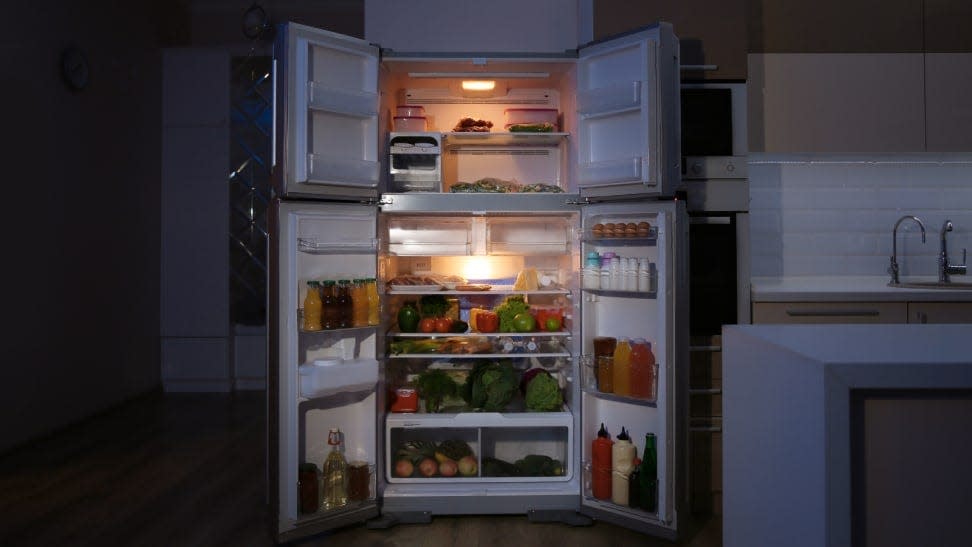How long does food stay good in refrigerator without power? What to know

Wednesday's ice storm knocked out power to many throughout metro Detroit and beyond.
That means plenty of refrigerators are sitting idle, creating food and waste issues.
Here’s what you need to do to keep food safe and know when and what has to be tossed out, according to the U.S. Department of Agriculture's Food Safety and Inspection Service and the Centers for Disease Control and Prevention. The first rule to remember is "when in doubt, throw it out." And also, never ever taste food to determine whether it's OK.
More:Rare Michigan ice storm leaves 1 dead, knocks out power to 700K customers
More:12 Lenten fish fry spots to try in metro Detroit
If your power was out just a few hours and you didn't open the refrigerator or freezer, chances are the food is fine. A refrigerator should keep food cold for four hours and a half-full freezer 24 hours (48 hours if the freezer is full) if you don't open the doors, according to the U.S. Department of Agriculture's Food Safety and Inspection Service.
Try not to open the refrigerator and freezer doors (doing so lets the cold air escape).
If you know the power will be out for an extended period, get ice or dry ice to keep foods cold. Fifty pounds of dry ice, the Food and Drug Administration says, should hold an 18-cubic-foot freezer for two days. Take care when handling dry ice, don't handle it with bare hands or place it directly on foods.
Use a refrigerator-freezer thermometer to check the temperature.
In either the refrigerator or freezer, if the temperature is 40 degrees or below, the food is safe.
The refrigerator will keep food safe for up to four hours. If the power is off longer, transfer the food to a cooler and fill with ice or frozen gel packs. You need to make sure there is enough ice to keep food in the cooler at 40 degrees or below — replenishing the ice as it begins to melt.
A full freezer will hold the temperature for approximately 48 hours (24 hours if it is half full).
Check the packages. If the food still contains ice crystals or is at 40 degrees or below when checked with a food thermometer, you can refreeze it, but the quality may not be the same.
Group foods together in the freezer to help them stay cold longer.
Keep food on ice in coolers.
Foods to toss
Bacteria growth can take place in these foods that have been above 40 degrees for two hours or more. Discard the following if your refrigerator has been without power for more than four hours:
Raw, cooked or leftover meat, poultry, fish, soft cheeses, milk, yogurt, eggs, leftovers, hot dogs, bacon, lunch meats, pizza, shredded cheeses, casseroles, pasta and pasta sauces, cut fruits and vegetables.
Cream-based salad dressings, sauces and soups.
Opened mayonnaise, tartar sauce and horseradish if they were held above 50 degrees for over eight hours.
Discard any foods like bread or salad greens that may have become contaminated by juices dripping from raw meat, poultry, or fish.
Pasta salads.
Sour cream-based or any dairy-based dips.
Fruits and vegetables that have become slimy or spoiled.
Toss out any food with an unusual odor, color or texture.
Foods to keep
Condiments, such as ketchup, mustard, jelly, jams, soy sauce, and bottled marinade. Typically, these have high salt and sugar content that can act as a preservative. Keep in mind that jams and jellies can grow mold after three or four days. Toss out ones that show signs of mold.
Butter/margarine.
Hard and processed cheese are typically fine.
Foods that don't actually require refrigeration like fresh herbs, spices, flour, and nuts.
Fresh bread and rolls.
Whole fruits and vegetables that show no signs of decay.
How to clean
Once the power is restored, here’s how to care for the inside of your refrigerator or freezer and rid them of any odors.
Dispose of any spoiled or questionable food.
Remove shelves, crispers, and ice trays. Wash them thoroughly with hot water and detergent. Then rinse with a sanitizing solution of 1 tablespoon of unscented, liquid chlorine bleach per gallon of drinking water.
Wash the interior of the refrigerator and freezer, including the door and gaskets, with hot water and baking soda. Rinse with a sanitizing solution.
Leave the door open for about 15 minutes.
Here's what to do if there is still an odor
Wipe the inside of the unit with equal parts of vinegar and water to destroy mildew.
Leave the door open and allow it to air out for several days.
Stuff the refrigerator and freezer with rolled newspapers. Keep the door closed for several days. Remove the newspaper and clean with vinegar and water.
Sprinkle fresh coffee grounds or baking soda loosely in a large, shallow container in the bottom of the unit.
Use a commercial product available at hardware and houseware stores. Follow the manufacturer's instructions.
The U.S. Department of Agriculture's Meat and Poultry hotline, 888-674-6854, is open 10 a.m. to 4 p.m. on weekdays.
Contact Detroit Free Press food writer Susan Selasky and send food and restaurant news to: sselasky@freepress.com. Follow @SusanMariecooks on Twitter.
Support local journalism and become a digital subscriber to the Free Press.
This article originally appeared on Detroit Free Press: How long does food stay good in fridge without power? What to know

